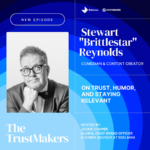By Anar Shah, CEO / Co-Founder, Background Noise
It’s hard to feel in control when your grocery bill shifts like a stock chart and your favorite brands toggle between “premium experiences” and “value basics” week-to-week. Consumers aren’t just watching the economy—they’re feeling it. In their wallets and their choices. And I suspect brand decision-makers themselves keenly understand the consumer plight as no one seems exempt from the undeniable fatigue of the shared moment.
2025 has delivered yet another cocktail of unpredictability: inflation reports that briefly offer hope, then undercut that feeling with warnings; tariff policies that shake global supply chains overnight; ongoing layoffs across industries; and Wall Street tremors that ripple into everyday decisions like, “Can I afford takeout tonight?”
Job security feels shaky. Savings are stretched thin. And even when the headlines are positive, people still brace for the next hit. While news cycles fixate on GDP and CPI, the more urgent, personal story is this: the everyday consumer is tired. Not just financially—but emotionally. That exhaustion is reshaping how people shop, what they trust, and how they engage with brands.
We saw this play out clearly during the height of COVID. Brands that stepped up—whether by leaning into self-care like Dieux Skincare and MyKirei, or reinforcing safety and trust like McDonald’s and Airbnb—weren’t just selling products. They offered emotional stability. They made people feel seen, comforted, and connected when everything else felt out of control.
That same energy is needed now. The current moment may not be marked by lockdowns, but it is shaped by uncertainty—economic, political, and emotional. Brands don’t need to be saviors, but they do need to be self-aware. This is the time to borrow from that COVID-era playbook: speak clearly, offer reassurance, create small moments of joy, and show your audience that you understand their reality. Not with performative empathy, but with marketing that feels human rather than transactional. People want to feel safe spending again. They want to be respected, not sold to.
This “tired consumer” isn’t difficult or disengaged—they’re just stretched thin. The brands that truly understand that—brands that shift their strategy and experience towards proven fatigue-relief and emotional comfort—will earn not just a sale, but lasting trust.
Reshaping marketing strategy to prioritize fairness, flexibility and emotional honesty requires an understanding of specific consumer stressors…
Inflation + Financial Fluctuation Fatigue
Yes, inflation stats might be easing, but real people are still adjusting. When you’ve spent months cutting back, rethinking wants vs. needs, and questioning every “treat,” you don’t just bounce back. Even small purchases carry weight. And the ongoing uncertainties continue to make these decisions harder than ever.
The brands looking to earn trust and relieve fatigue will be honest about pricing— with no games, no gimmicks. They will offer loyalty programs that feel human versus transactional. And they’ll build in flexibility—subscriptions with pause buttons, and bundles that don’t force upsells. Customer service programs that are more empathetic than ever before can find trust among audiences who’ve felt deprioritized.
Tariffs + The Fallout Consumers Didn’t Sign Up For
Consumers didn’t choose trade wars. But they’re the ones who feel it when prices jump or shelves look empty. The recent 90-day tariff pause sounds positive, but it’s just another chapter in a story that keeps people guessing leading to more uncertainties.
Brands show up better when they explain product and pricing changes with full transparency. Think: “This is why this item is out of stock.” Along the consumer journey, highlight local sourcing or ethical practices when they exist; no spin, just real talk. Consumers appreciate when they feel honesty from brands who feel as vulnerable as they do during these mad times. And be steady with your approach. This is not the time for knee-jerk reactions. Constant price changes make people feel like they’re increasingly losing control.
Heightened Demand for Small Joys
If there’s one bright spot in all of this, it’s that people are still reaching for moments of joy. But those joys are still a response to the stress. Gen Z’s “little treat” culture says a lot—they’re not splurging, but they still want something to look forward to. A lip balm, a fizzy drink, a moment of softness. That’s where brand love still lives.
So brands must lean into comfort, not aspiration. “We see you” hits harder than “You deserve luxury.” It’s just not the right time for the latter. Make indulgence accessible, with small sizes, thoughtful pricing. And bring emotional reward by tapping into brand elements like memory, feeling, and texture. We all want to feel something good right now.
The urgent opportunity is to treat people like they’re people, versus transactions. Let’s be real: everyone’s just trying their best. When the world feels out of control, what consumers want is simple—clarity, care, and choice. Brands don’t need to shout. They need to show up with empathy instead of pressure, consistency instead of volatility, and honest value instead of inflated promises.
The tired consumer isn’t unreachable. Reach them with a tangible shift towards respect and understanding. If you can be that kind of brand, you’ll matter—now and long after the headlines shift.











